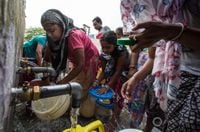It’s a sobering statistic: in 2025, one in four people on the planet still lack access to safe drinking water. That’s the stark finding from a joint report by the World Health Organisation (WHO) and UNICEF, released in Stockholm during World Water Week. Despite years of global pledges and some progress, 2.1 billion people—roughly the population of Africa and Europe combined—are left without a basic necessity most take for granted. The water crisis, however, is not confined to drinking water alone. The same report reveals that 3.4 billion people live without safe sanitation, and 1.7 billion lack access to hygiene at home. For many, even a simple hand-washing facility is a luxury.
The numbers are staggering. According to the WHO and UNICEF, in 2024, 1.4 billion people had only basic water services, 287 million had limited services, 302 million relied on unimproved sources, and 106 million were forced to drink directly from surface water. Sanitation, too, paints a grim picture: 1.9 billion people get by with basic services, 560 million with limited options, while 354 million still practice open defecation. Hygiene remains out of reach for hundreds of millions, with 611 million people unable to wash their hands at home. And while three out of five people globally now have safely managed sanitation, the odds are twice as bad for those living in the world’s least developed countries.
Why is this happening? The reasons are as complex as they are urgent. Conflict zones are hit hardest, with safe water access 38 percentage points lower than in stable countries. Rural areas have seen some progress—clean water coverage climbed from 50% in 2015 to 60% in 2024, and basic hygiene access jumped from 52% to 71%—but urban improvements have lagged. The burden falls heaviest on women and girls, who often walk over half an hour each day to fetch water. Poor sanitation forces many girls to miss school during their periods, perpetuating cycles of disadvantage.
“Water, sanitation, and hygiene are not privileges; they are basic human rights. We must accelerate action, especially for the most marginalised communities, if we are to keep our promise to reach the Sustainable Development Goals,” said Ruediger Krech, WHO’s environment chief, in the report. UNICEF’s director of water, sanitation, and hygiene, Cecilia Scharp, added, “When children lack safe water and sanitation, their health, learning and future are at risk. The impact is especially heavy on girls, who often carry the biggest burden.”
The consequences of inaction are dire. The world is poised to miss the UN’s 2030 goal of safe water and sanitation for all without urgent intervention. But the water crisis doesn’t stop at the tap. It’s intimately tied to climate change, agriculture, and how societies manage their most precious resource. Nowhere is this more evident than in Morocco, where water stress has reached alarming new heights.
As of August 2025, Morocco’s water reserves stood at just 5.729 billion cubic meters—only 34.1% of dam capacity, and a drop from 5.92 billion cubic meters at the start of the month. The Moroccan Ministry of Equipment and Water’s figures highlight an accelerated rate of water loss, echoing warnings from the Moroccan Institute for Strategic Intelligence. Their report blames climate change, unsustainable agricultural policies, poor resource management, and rampant groundwater overuse for the escalating crisis.
International experts are sounding the alarm. The US National Drought Mitigation Centre, in its Global Drought Zones 2023-2025 report, warns that Morocco could fall into ‘extreme water scarcity’ by 2050 if current practices persist. Droughts, always a feature of Morocco’s arid climate, have intensified since the 20th century. The past six years have been especially dry, with 2022 marking the driest year in three decades.
King Mohammed VI, addressing the nation on the 25th anniversary of Throne Day, underscored the urgency: “The most important challenge facing Morocco lies in the water problem, which is being exacerbated by drought and the impact of climate change, in addition to the natural increase in demand and the delay in the implementation of some planned projects within the framework of water policy.”
The crisis is not evenly distributed. The Bouregreg basin, for example, holds about 653 million cubic meters of drinking water, while the Souss Massa basin manages with just 136 million. To address these disparities, Morocco is taking action. The government is improving dam management, building desalination plants, reusing wastewater for irrigation, and accelerating water transfer projects between basins. Minister Nizar Baraka made it clear in June 2025: “The nation cannot continue to rely exclusively on water reservoirs, as dams are no longer sufficient.” Desalination and wastewater reuse are now seen as vital alternatives.
Public awareness campaigns are also underway. In July, the Casablanca-Settat Regional Multiple Services Company launched a drive to promote water-saving habits, while the Amal Salé Association highlighted the plight of villagers forced to travel long distances for water. Youssef Chafaoui, the association’s president, explained, “The campaign is an opportunity to highlight the difficulties faced by villagers. (...) Where citizens are forced to travel long distances to access the water they need.”
This local struggle is part of a much bigger global story—one that’s also playing out in the American West. In California’s San Joaquin Valley, groundwater depletion has become a serious issue, particularly over the past 20 years. According to Edward Ring, Director of Water and Energy Policy at the California Policy Center, the shift from flood to drip irrigation, combined with regulations that prioritize river flow over farming, has worsened the problem. Ring, writing in ProPublica, points to a recent study that found groundwater depletion now contributes about 0.7 millimeters per year to sea level rise—on par with Greenland’s melting icecap, and exceeding Antarctica’s contribution.
Ring argues that while climate change is a major driver, focusing solely on it can distract from actionable solutions. “The hazard inherent in wrapping every environmental challenge in the language of a climate crisis is that it can limit what might otherwise be effective solutions,” he writes. In California, he suggests dredging the Sacramento-San Joaquin Delta channels to restore their historic depth could help revive fish populations, provide more water for farmers, and recharge depleted aquifers. “If that were done, we could save the fish at the same time as we release additional millions of acre feet of water back to the San Joaquin Valley farmers, so they could grow crops while also recharging their depleted aquifers.”
Globally, groundwater depletion is a silent crisis. The Food and Agricultural Organization estimates that 4 trillion cubic meters of water are withdrawn each year, with 70% going to agriculture. Of that, a quarter comes from aquifers, and half of all urban and industrial withdrawals also rely on groundwater. The recent study cited by Ring calculates that only about 10% of groundwater withdrawals end up in the ocean, due to percolation, evapotranspiration, or reuse. Still, the impact is real: land subsidence, shrinking freshwater availability, and growing stress on both people and ecosystems.
What’s the way forward? Experts agree on several fronts: invest in infrastructure, promote conservation, rethink agricultural models, and empower local communities. Above all, the world must move beyond rhetoric and act with urgency. The numbers are clear, the stakes are high, and the time for half-measures is over.
The global water crisis is not just about statistics—it’s about people, livelihoods, and the future of entire regions. Whether in Morocco, California, or the world’s poorest communities, the challenge is the same: to secure water for all, before the well runs dry.





